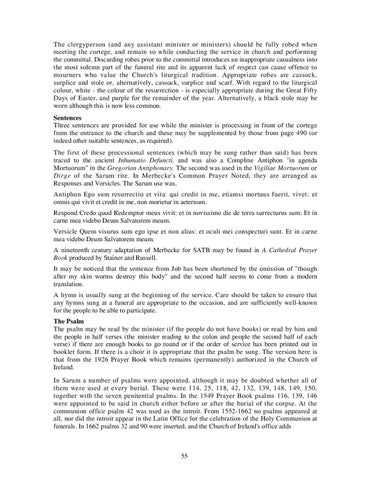The clergyperson (and any assistant minister or ministers) should be fully robed when meeting the cortege, and remain so while conducting the service in church and performing the committal. Discarding robes prior to the committal introduces an inappropriate casualness into the most solemn part of the funeral rite and its apparent lack of respect can cause offence to mourners who value the Church's liturgical tradition. Appropriate robes are cassock, surplice and stole or, alternatively, cassock, surplice and scarf. With regard to the liturgical colour, white - the colour of the resurrection - is especially appropriate during the Great Fifty Days of Easter, and purple for the remainder of the year. Alternatively, a black stole may be worn although this is now less common. Sentences Three sentences are provided for use while the minister is processing in front of the cortege from the entrance to the church and these may be supplemented by those from page 490 (or indeed other suitable sentences, as required). The first of these processional sentences (which may be sung rather than said) has been traced to the ancient Inhumatio Defuncti, and was also a Compline Antiphon "in agenda Mortuorum" in the Gregorian Antiphonary. The second was used in the Vigiliae Mortuorum or Dirge of the Sarum rite. In Merbecke's Common Prayer Noted, they are arranged as Responses and Versicles. The Sarum use was, Antiphon Ego sum resurrectio et vita: qui credit in me, etiamsi mortuus fuerit, vivet: et omnis qui vivit et credit in me, non morietur in aeternum. Respond Credo quod Redemptor meus vivit: et in novissimo die de terra surrecturus sum: Et in carne mea videbo Deum Salvatorem meum. Versicle Quem visurus sum ego ipse et non alius: et oculi mei conspecturi sunt. Et in carne mea videbo Deum Salvatorem meum. A nineteenth century adaptation of Merbecke for SATB may be found in A Cathedral Prayer Book produced by Stainer and Russell. It may be noticed that the sentence from Job has been shortened by the omission of "though after my skin worms destroy this body" and the second half seems to come from a modern translation. A hymn is usually sung at the beginning of the service. Care should be taken to ensure that any hymns sung at a funeral are appropriate to the occasion, and are sufficiently well-known for the people to be able to participate. The Psalm The psalm may be read by the minister (if the people do not have books) or read by him and the people in half verses (the minister reading to the colon and people the second half of each verse) if there are enough books to go round or if the order of service has been printed out in booklet form. If there is a choir it is appropriate that the psalm be sung. The version here is that from the 1926 Prayer Book which remains (permanently) authorized in the Church of Ireland. In Sarum a number of psalms were appointed, although it may be doubted whether all of them were used at every burial. These were 114, 25, 118, 42, 132, 139, 148, 149, 150, together with the seven penitential psalms. In the 1549 Prayer Book psalms 116, 139, 146 were appointed to be said in church either before or after the burial of the corpse. At the communion office psalm 42 was used as the introit. From 1552-1662 no psalms appeared at all, nor did the introit appear in the Latin Office for the celebration of the Holy Communion at funerals. In 1662 psalms 32 and 90 were inserted, and the Church of Ireland's office adds
55
